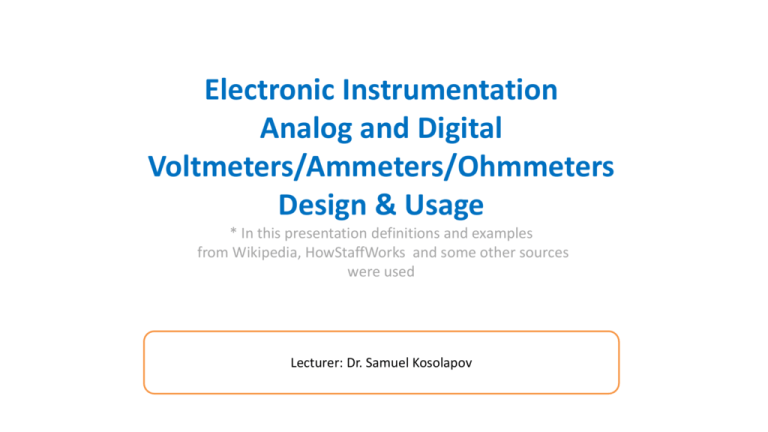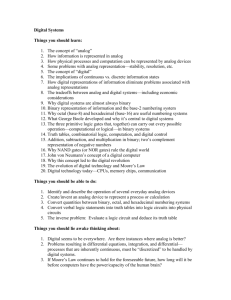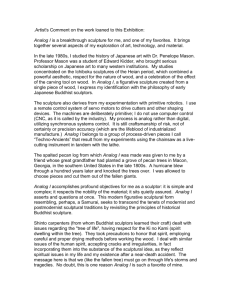Analog and Digital Multimeters - Welcome to brd4.braude.ac.il!
advertisement

Electronic Instrumentation
Analog and Digital
Voltmeters/Ammeters/Ohmmeters
Design & Usage
* In this presentation definitions and examples
from Wikipedia, HowStaffWorks and some other sources
were used
Lecturer: Dr. Samuel Kosolapov
Items to be
defined/refreshed/discussed
•
•
•
•
•
•
•
Operation of Analog Galvanometer
Converting Galvanometer to Voltmeter
Multi-Range Analog Voltmeter & Ammeter
AC Analog Ammeter
Analog Ohmmeter
Outdated Analog Multimeter design
Analog Multimeter with Analog Amplifier
2
Items to be
defined/refreshed/discussed
• Digital Multimeter
• Arduino based Multimeter
• Usage of Digital Voltmeter to measure
resistance (Why not to use Ohmmeter ?)
• Wheatstone Bridge Usage
• What about Capacitance measurements ?
3
Analog Galvanometer
http://pediaa.com/difference-between-galvanometer-and-voltmeter/
Galvanometer is a device which has parts that move in response to an electric current
4
Analog Voltmeter
http://pediaa.com/difference-between-galvanometer-and-voltmeter/
A voltmeter is a device which,
when connected across two points on an electric circuit,
measures the potential difference between those two points
Galvanometers can be used to make voltmeters.
The needle of a galvanometer moves in response to current,
but if we know the resistance of the coil,
then we can use Ohm’s law to determine
the corresponding potential difference
between the two ends of a voltmeter.
Voltmeter Calibration:
We could set up a scale next to the needle
that reads the values of potential difference
corresponding to the needle’s position
+ Manual ZERO correction (rotate spring…)
Analog Voltmeter: Problems
Periodical Calibration is needed
Low accuracy
Values must be logged manually
5
Galvanometer Voltmeter
http://www.allaboutcircuits.com/textbook/direct-current/chpt-8/voltmeter-design/
Using Ohm’s Law (V=IR),
we can determine how much voltage
will drive this meter movement
directly to full scale:
V=IR
V = (1 mA)(500 Ω)
V = 0.5 volts
How to measure bigger voltages ?
Add additional resistor.
6
Multi-Range Analog Voltmeter
http://www.allaboutcircuits.com/textbook/direct-current/chpt-8/voltmeter-design/
More practical design
7
Analog Voltmeter Impact on Measuring Circuit
http://www.allaboutcircuits.com/textbook/direct-current/chpt-8/voltmeter-design/
Every meter impacts the circuit it is measuring to some extent.
While some impact is inevitable, it can be minimized through good meter design.
Voltmeters are always connected in parallel with the component under test.
A perfect voltmeter has infinite resistance, so that it draws no current from the circuit under test.
However, perfect voltmeters only exist in the pages of textbooks, not in real life!
Loading Effect
Wrong !!!
8
Multi-Range Analog Ammeter design
http://www.allaboutcircuits.com/textbook/direct-current/chpt-8/voltmeter-design/
Shunt resistor values are very low!
To achieve these low resistances, ammeter shunt resistors often have to be
custom-made from relatively large-diameter wire or solid pieces of metal.
To measure current
EE must break the circuit.
This is why Ammeters are
practically never used in
real life electronics
9
AC Analog Ammeter design
https://www.ibiblio.org/kuphaldt/electricCircuits/AC/AC_12.html
Problem: Diodes are NON LINEAR
Scale is not linear
Special Scale for AC must be printed
10
Analog Ohmmeter design
http://www.allaboutcircuits.com/textbook/direct-current/chpt-8/voltmeter-design/
Current is a function of R + Rx between black and red leads
But scale is NOT Linear !!!
Example: if current of 0.5 mA then
R + Rx = 9V/0.5 mA = 18 k
Rx = 18 – 8.5 – 0.5 = 9 k
Q. Can EE measure resistance of the component on the PCB ?
11
Outdated Analog Multimeter design
12
Analog Voltmeter with Analog Amplifier
http://www.allaboutcircuits.com/textbook/direct-current/chpt-8/voltmeter-design/
Amplifier can has nearly INFINITE input resistance. (FET, OA)
In case galvanometer is used, Voltage to Current converter must be used
13
High Impedance DC Votmeter
http://www.circuitstoday.com/high-impedance-dc-voltmeter
Diodes D1 and D2 protect the IC
from accidental excessive
input voltages
Diodes D3 and D4 protect the
meter from overloads.
14
Analog Ammeter with Analog Amplifier
http://www.allaboutcircuits.com/textbook/direct-current/chpt-8/voltmeter-design/
Voltmeter with
Amplifier
Input Resistance can
be set as HUGE
15
Linear AC Analog Voltmeter with Analog Amplifier
http://www.angelfire.com/planet/funwithtransistors/Book_CHAP-7.html
16
Digital Voltmeter (of Stone Age)
17
Digital Multimeter
http://www.vsagar.org/how-digital-multimeter-works/
18
Digital Multimeter. Voltage Attenuator
http://www.vsagar.org/how-digital-multimeter-works/
The commercial DMM has a rotary switch used selecting
proper range with many steps in it.
19
Arduino Based Multimeter.
/
Will be proposed as FINAL Project
http://www.instructables.com/id/Digital-multimeter-shield-for-Arduino/
The shield can be inserted on "Arduino" UNO und Duemilanove boards.
It can work in three modes:
standalone - the measurement data can be seen at the character or graphical LCM
connected - the measurement data can be read on the PC screen using the "Arduino" IDE "Serial monitor"
combined - the data can be observed on both devices
The second mode does not require the presence of LCM, what makes the shield very cheap.
The "Arduino" based DMM has the following functions:
voltmeter with 3 ranges : 0-10V; 0-30V; 0-100V
amperemeter - it has a range 0-500mA
ohmmeter with 2 ranhes : 0-1KOhm, 0-250KOhm
diode, LED, connectivity checker
LED functionality tester
NPN BJT Beta meter
20
Digital Multimeter. Current to Voltage Conversion
http://www.vsagar.org/how-digital-multimeter-works/
The commercial DMM has a rotary switch used selecting
proper range with many steps in it.
21
Measuring resistance with DC. Circuit A
Extremely simple circuit.
Problem: Two identical
voltmeters are needed.
Q. Why not to use Digital Ohmmeter ?
A. We want to control the voltage and current while
measurements. (We do not know which current and I
which direction flows
Q041. Derive relevant equation for R2 calculation
by known V1, R1, and Vr2 (Voltage on R2)
Q042. Calculate numerical value of R2
22
Measuring resistors with DC. Circuit B
Switch added
Only one Voltmeter is needed
Problem: Operator must manually log and process the data
The accuracy of an analog ammeter or voltmeter
is usually stated as a percent of the full-scale reading.
Example:
The Ququ analog meters are accurate to ±2% of the full scale reading.
Thus for a reading of 1.00V on a 3 volt scale, the uncertainty is ±0.06V.
A reading of 1.0V on the 30 volt scale will have an uncertainty of 0.6V.
For a digital multimeter (DMM : XMM1),
accuracy is usually specified as a percent of the reading
So a meter with a specification of 1% of the reading will read an actual
value of 100.0V as something between 99.0V and 101.0V.
23
Measuring resistors with DC. Circuit B.
Measurement Error
𝑉𝑅2 =
𝑅2
× 𝑉1
𝑅1 + 𝑅2
𝑅2 =
𝑉1
× 𝑅1
𝑉1 − 𝑉𝑅2
Reminder:
Absolute Error
and Relative Error
Equation for Error evaluation is not trivial even in this trivial case
Fast evaluation Option is: Worst Case Evaluation
R1 value is known with 1% accuracy.
Digital voltmeter XMM1 accuracy is 1%
Q043. Calculate Worst Case Range of R2: {R2min .. R2max}
24
Wheatstone Bridge
(By TI Precision Analog Applications Seminar)
http://www.ti.com/lit/ml/slyp163/slyp163.pdf
A load cell is important sensor. Used in weight scales (balances)
25
Strain Gauge
http://www.sensorland.com/HowPage002.html
Strain gauge is used to measure pressure, load, torque
(depending on mechanical design)
Inside: resistive foil
which is mounted on a backing material.
When the foil is subjected to stress,
the resistance of the foil changes in a defined way
BUT: Change of the resistance of the foil is VERY SMALL
Special circuitry is required to measure force properly
26
Wheatstone Bridge
(By TI Precision Analog Applications Seminar)
http://www.ti.com/lit/ml/slyp163/slyp163.pdf
Problems
1. Relation between Rg and Vo is not linear
2. Vo has a big “DC offset”. Then it is not easy to measure small voltage changes.
Example: DC offset is 5V, “Voltage change” is 1 mV
27
Wheatstone Bridge
(By TI Precision Analog Applications Seminar)
http://www.ti.com/lit/ml/slyp163/slyp163.pdf
Invented by Hunter Christie (1833). Studied by Charles Wheatstone
If the current (or voltage) in the cross branch is zero,
and THREE resistance are known,
the FOURTH resistance can be calculated
1. IMPORTANT: Voltage of VE is not important
2. “ZERO” Voltage / Current is easy to detect
28
Wheatstone Bridge
(By TI Precision Analog Applications Seminar)
http://www.ti.com/lit/ml/slyp163/slyp163.pdf
==
R1:=R
Removing the offset:
R1==R is selected close to “some” value of Rg
Then offset is eliminated
And Vo is nearly proportional to “DELTA”
(Because R >> “Delta”0
𝑅𝑔 = 𝑅1 + ∆
𝑅
1
𝑉𝑜 =
−
𝑉𝑒
2𝑅 + Δ
2
Vo =
−∆
4𝑅+2∆
𝑉𝑒
29
Wheatstone Bridge
(By TI Precision Analog Applications Seminar)
http://www.ti.com/lit/ml/slyp163/slyp163.pdf
This configuration is called :
“Single-point Bridge Sensor”
Actually, Voltage and not current is measured here
Two identical “Load Sensors” can be positioned in
TWO points (Two Point Bridge)
Upper and Bottom strain gauges connected
oppositely: (R+Delta) and (R-Delta)
Q044. Prove that THIS improves scales sensitivity
by a factor 2.
30
Wheatstone Bridge
(By TI Precision Analog Applications Seminar)
http://www.ti.com/lit/ml/slyp163/slyp163.pdf
This configuration is called :
“Four-point Bridge Sensor”
Very Linear and Very Sensitive Configuration !!!
(May be I’ll ask to prove this on final exam…)
31
Strain Gauge in Weighting Scales
http://www.ti.com/lit/ml/slyp163/slyp163.pdf
Typical parameters:
Resistances are in the range of 1k
“Sensitivity” is expressed in mV/V
This means that 10 V excitation with 2mV/V sensor results in change 20 mV only
Additional important parameters:
Offset error: Voltage Produced when the measurement parameter is zero
Full-scale Error: Difference between the ideal voltage when the measurement parameter is at maximum
Temperature Drift: change of the above as temperature varies
Aging error: change of the above as time is running
Non-linearity: Deviation of graph {Output Parameter - Measured Parameter”} from a straight line
32
Offset calibration for a Weight Scale
http://www.ti.com/lit/ml/slyp163/slyp163.pdf
In “Analog” scales some “potentiometer” can be manually rotated.
Digital Scales uses software to evaluate and store current offset value (Think How before exam)
33
Gain calibration for a Weight Scale
http://www.ti.com/lit/ml/slyp163/slyp163.pdf
In “Analog” scales some “potentiometer” can be manually rotated.
Digital Scales uses software to evaluate and store current “Gain” value (Think How before exam)
34
Exemplary Design of Weight Scale
http://www.ti.com/lit/ml/slyp163/slyp163.pdf
Signal from Wheatstone Bridge is amplified by some Diff OA (or Instrumental OA)
Then 0-20 mV range 0-5V range.
LPF is a must (remind why)
ADC of different types can be used.
Vexcitation is used as for Wheatstone Bidge as for REF for ADC
(For better ADC Accuracy)
MCU is Arduino pin A0.
5 Sec after power ON Arduino measure “offset” and store it
Then “weight” measurements starts.
Q045. Write short Arduino Sketch that take into account stored “OFFSET”
Send results every 1 sec to Serial Monitor
35
Measuring Capacitors with DC and Voltmeter ?
Practically impossible:
Voltmeter is too slow
Oscilloscope and Signal Generator must be used
36
Control Questions
• What have I learned ?
37
Literature to read
1. TBD
38






